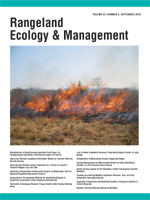Mongolia's Eastern Steppe is one of the largest remaining temperate grassland ecosystems and is habitat for Mongolian gazelles (Procapra gutturosa). During four surveys, we quantified vegetation composition, forage quality, and trace elements to gain insights on characteristics of forage that could be influencing how gazelles are distributed across the steppe. Grasses made up between 57% and 68% of all species, Stipa spp. (24–42% of all grasses) being the most abundant. Forbs made up 6% to 23% of all species with Allium spp. (11–44% of all forbs) the most abundant. The shrubs and dwarf shrubs were least common (7% and 12% of all species) with Artemisia frigida Willd. (18% and 47% of all shrubs) most common. Spring crude protein values of green vegetation averaged 21.9%. Considered an important forage for gazelles, Stipa spp. was below optimum value in phosphorous (P) and magnesium (Mg). The forbs Allium spp. and Astragalus spp. and the dwarf shrub Artemisia frigida had some of the highest crude protein contents and were above optimum for all important elements (except P in Astragalus). Calcium (Ca) and the Ca∶ P ratio were above optimal at nearly all sites surveyed. Phosphorus levels in vegetation were 96% of minimum requirements for ungulates at maintenance whereas magnesium and calcium were 113% and 145% of minimum requirements for ungulates, respectively. Magnesium and phosphorous were below values considered optimal for lactation and bone development at 78% and 71% of sites, respectively. Gazelles likely satisfy their nutrient requirements by selectively foraging on species that contain high concentrations of critical minerals. During periods of peak demands, particularly calving and postcalving periods, regions with a high abundance of forbs commonly occurring in gazelle diets (Allium and Astragalus) might be of greater value to lactating females and growing calves and, therefore, sought out.
How to translate text using browser tools
1 September 2010
Vegetation Composition and Nutritional Quality of Forage for Gazelles in Eastern Mongolia
Kirk A. Olson,
Martyn G. Murray,
Todd K. Fuller
ACCESS THE FULL ARTICLE
forage value
grazing ecosystem
nutrient requirements
plant–herbivore interactions
Procapra gutturosa
ungulate ecology





